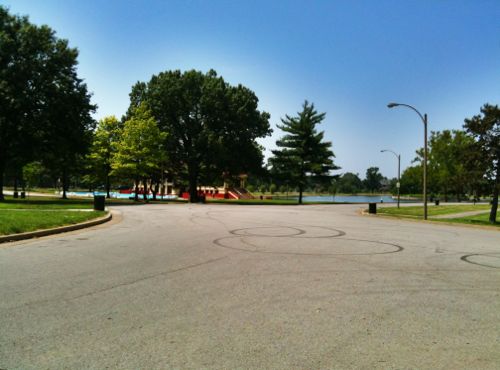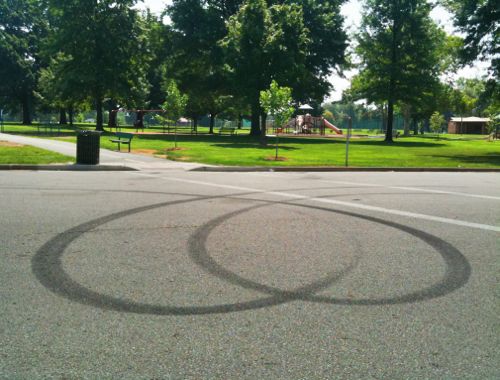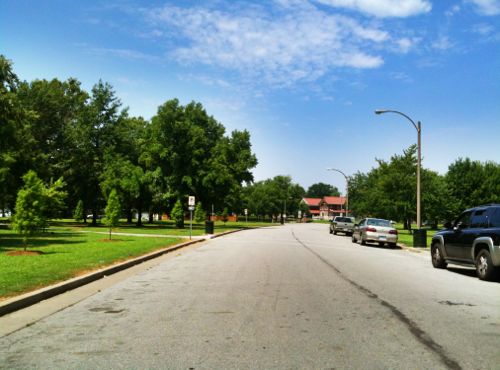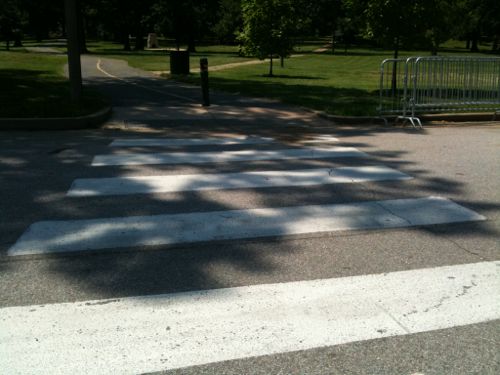Speed Bump Bill Hits a Bump in the Political Road

Recently the humble speed bump was elevated to a political issue, from MayorSlay.com:
“Today, I vetoed an odd little bill that would have paid for the installation of speed bumps in one of the city’s 105 parks. The bill’s sponsor ignored the testimony of the Streets Department that there were better and more effective ways to slow traffic and the opinion of the city counselor that such constructions are legally questionable under state and Federal law.
At my direction, the city’s operations director will work with the directors of the Parks and Streets Departments, the city’s chief engineer, the park’s users, and the bill’s sponsor to find appropriate, effective, and legal measures to calm traffic along that stretch of park road. If the issue is safety, not aldermanic courtesy, that will solve the problem.”
The sponsor was 21st ward alderman, Antonio French, a personal friend of many years. The bill was BB43.

I visited O’Fallon Park to check out the places where French wanted speed bumps, namely two points where the newish jogging trail crossing the main internal road in the park. I can certainly see why he wanted something to slow traffic, neither crossing point is marked other than two faint crosswalk lines.
The phrase “speed bump” doesn’t really apply in the case of O’Fallon Park, speed hump is better:
Speed humps are rounded raised areas placed across the roadway. They are generally 10 to 14 feet long (in the direction of travel), making them distinct from the shorter “speed bumps†found in many parking lots, and are 3 to 4 inches high. The profile of a speed hump can be circular, parabolic, or sinusoidal. They are often tapered as they reach the curb on each end to allow unimpeded drainage.
They are both inexpensive and effective. Â But the mayor questioned the legality in his blog post on the veto:
The mayor is referring to the recommendation he received from the city counselor’s office, which told him in a statement, “since speed bumps are not explicitly permitted in [Missouri Statutes section] 304.120, they logically fall under the category of prohibited obstructions in [section] 229.030.” The counselor’s office goes on to state that the speed bumps would create additional legal liability for the City. (RFT)
At the request of the Post-Dispatch, the local [MoDOT]Â office researched state law on the issue, and found no reference whatsoever to speed “bumps,” which are in parking lots, or “humps,” which are in streets, said Traffic Operations Engineer Brian Umfleet.
And the law, Umfleet said today, typically spells out what is illegal. Roundabouts, for instance, aren’t in state law either. Nor are some of the newer, fancier traffic-control methods, such as the “Diverging Diamond,” at Dorsett Road and Interstate 270 – yet MoDOT builds those, too. (STLtoday.com)


How could these crossings have only two narrow crosswalk lines and no signs at all? I wondered if this was the norm so at first I visited O’Fallon’s south side counterpart, Carondelet Park.

The crosswalks in Carondelet Park are significantly more visible than the standard crosswalk markings in O’Fallon Park.

I personally prefer the Zebra or Ladder styles of crosswalk markings.

It would appear the city skimped on pedestrian safety when the jogging path was completed in O’Fallon Park, relative to Carondelet Park at least. Â Forest Park uses textured pavement near such crossings to slow traffic, in addition to warning signs. It amazes me French had to introduce a bill and have the mayor veto the bill over something that should have been included with the original installation of the jogging path.
– Steve Patterson
I would defer to a trained traffic engineer any day, over an elected alderman. The insane number of 4-way stops in the city should be enough evidence of what happens when you have politicians mandating knee-jerk solutions to traffic problems. The problem here, like so many others, is simply one of enforcement. Slowing down traffic won’t make things safer; having them actually stop and yield will, but that won’t happen until the police start writing some tickets!
I would defer to a trained traffic engineer any day, over an elected alderman. The insane number of 4-way stops in the city should be enough evidence of what happens when you have politicians mandating knee-jerk solutions to traffic problems. The problem here, like so many others, is simply one of enforcement. Slowing down traffic won’t make things safer; having them actually stop and yield will, but that won’t happen until the police start writing some tickets!
Agreed, but it’s clear zero provisions have been made to protect pedestrians.
Zero?! There’s a marked crosswalk! Maybe not the best, but it IS marked. Remember, this is a park, you have people crossing the street everywhere. The “problem” is that St. Louis drivers are not conditioned to look for, nor yield to, pedestrians, not at signalized intersections, not a 4-way stops, and certainly not at mid-block crosswalks! I get it, we have laws that say drivers must yield. Guess what? They’re not enforced! Yes, different design solutions will make things marginally better, but it won’t change the underlying problem. Stop means stop in California, it means very little in St. Louis! And it hurts only marginally less to be hit by a vehicle going 15 mph than it does by one going 25 or 30 mph!
But, if you really want to improve things, quickly and inexpensively, how about prohibiting (and enforcing) parking within 100′ of the crosswalk, to improve visibility for both drivers and pedestrians? It still won’t solve the underlying problem (see above), but it will give pedestrians more of a fighting chance . . .
This is one of the city’s most beautiful parks and it should be for pedestrians not reckless drivers. People on foot don’t need a ‘fighting chance.’ They should have the same amount of traffic calming as in other St. Louis City parks. The reason they weren’t given equal protection is because Mr. French has been a critic of Slay for years and this is a North Side Ward.
I have to disagree with your statement “And it hurts only marginally less to be hit by a vehicle going 15 mph than it does by one going 25 or 30 mph!” Being struck by a vehicle going 25 or 30 mph is much more likely to result in a fatality than being struck by one going 15 mph.
Agreed, but it’s clear zero provisions have been made to protect pedestrians.
Zero?! There’s a marked crosswalk! Maybe not the best, but it IS marked. Remember, this is a park, you have people crossing the street everywhere. The “problem” is that St. Louis drivers are not conditioned to look for, nor yield to, pedestrians, not at signalized intersections, not a 4-way stops, and certainly not at mid-block crosswalks! I get it, we have laws that say drivers must yield. Guess what? They’re not enforced! Yes, different design solutions will make things marginally better, but it won’t change the underlying problem. Stop means stop in California, it means very little in St. Louis! And it hurts only marginally less to be hit by a vehicle going 15 mph than it does by one going 25 or 30 mph!
But, if you really want to improve things, quickly and inexpensively, how about prohibiting (and enforcing) parking within 100′ of the crosswalk, to improve visibility for both drivers and pedestrians? It still won’t solve the underlying problem (see above), but it will give pedestrians more of a fighting chance . . .
So they’ll be removing the speed bumps in Tower Grove Park?
So they’ll be removing the speed bumps in Tower Grove Park?
So they’ll be removing the speed bumps in Tower Grove Park?
I don’t think the city paid for the speedbumps in Tower Grove Park.
I also take exception with your simplistic comaprison of the three distinct investments in O’Fallon, Carondelet and Forest Parks. Every project has/had a budget and every design requires/required compromises to stay within that budget. If more money had been invested in “better” crosswalks in O’Fallon Park, less money would have been available for the path, itself, meaning either a shorter path or an incomplete path. With the clarity of 20/20 hindsight, you may not like these particular choices, but I seriously doubt that you were part of the original decision-making process.
There probably is, and needs to be, a larger discussion about using private funds to improve only certain, specific public parks (both Carondelet Park and Forest Park have benefactors and “friends” groups, I’m guessing that O’Fallon does not), over and above some arbitrary city “standard”. Much like public education, should we all be truly “equal”, or, should the rich be able to pay for better? The city Parks Department has limited resources, and they try to stretch them as far as possible, which means doing just the minimum, in many cases, but doing it citywide. They’re also stuck with the reality that maintenance doesn’t generate photo ops for aldermen, while new construction does. So, as a city, should we expect to have a few “crown jewels” in the system, or should we expect to turn away private donors, all in the name of “equity”?
I also take exception with your simplistic comaprison of the three distinct investments in O’Fallon, Carondelet and Forest Parks. Every project has/had a budget and every design requires/required compromises to stay within that budget. If more money had been invested in “better” crosswalks in O’Fallon Park, less money would have been available for the path, itself, meaning either a shorter path or an incomplete path. With the clarity of 20/20 hindsight, you may not like these particular choices, but I seriously doubt that you were part of the original decision-making process.
There probably is, and needs to be, a larger discussion about using private funds to improve only certain, specific public parks (both Carondelet Park and Forest Park have benefactors and “friends” groups, I’m guessing that O’Fallon does not), over and above some arbitrary city “standard”. Much like public education, should we all be truly “equal”, or, should the rich be able to pay for better? The city Parks Department has limited resources, and they try to stretch them as far as possible, which means doing just the minimum, in many cases, but doing it citywide. They’re also stuck with the reality that maintenance doesn’t generate photo ops for aldermen, while new construction does. So, as a city, should we expect to have a few “crown jewels” in the system, or should we expect to turn away private donors, all in the name of “equity”?
I also take exception with your simplistic comaprison of the three distinct investments in O’Fallon, Carondelet and Forest Parks. Every project has/had a budget and every design requires/required compromises to stay within that budget. If more money had been invested in “better” crosswalks in O’Fallon Park, less money would have been available for the path, itself, meaning either a shorter path or an incomplete path. With the clarity of 20/20 hindsight, you may not like these particular choices, but I seriously doubt that you were part of the original decision-making process.
There probably is, and needs to be, a larger discussion about using private funds to improve only certain, specific public parks (both Carondelet Park and Forest Park have benefactors and “friends” groups, I’m guessing that O’Fallon does not), over and above some arbitrary city “standard”. Much like public education, should we all be truly “equal”, or, should the rich be able to pay for better? The city Parks Department has limited resources, and they try to stretch them as far as possible, which means doing just the minimum, in many cases, but doing it citywide. They’re also stuck with the reality that maintenance doesn’t generate photo ops for aldermen, while new construction does. So, as a city, should we expect to have a few “crown jewels” in the system, or should we expect to turn away private donors, all in the name of “equity”?
Aldermen are elected officials and aware of Parks and Recreation’s budget since they make it. This isn’t a finance issue and what are private donors having to do with anything? Did Jack Danforth offer to improve O’Fallon Park? This is about installing some speed bumps and it should be no more complicated than fixing a stop sign, which is a ‘routine aldermanic responsibility.’
There are two separate issues here, what to do to better-protect pedestrians (after the fact) and why there are differences in how projects are completed in various city parks. Every project has a budget and it is never enough to do everything everyone wants done, so compromises are inevitable. What gets allocated in the budget IS a political issue, but once it’s defined, it is what it is. You either have to find more money from private donors or you need to scale back the project to fit the available funds. The cobbletone crosswalks with bulbouts in Forest Park are a perfect example. They do a much better job of defining a pedestrian crossing, but they also cost more than just painting the asphalt. I’m pretty sure Forest Park Forever paid for these, not the city parks department. Is it “fair” that Forset Park gets better crosswalks? Or, should the parks department budget be “adjusted”, to send more money to parks that don’t get extra funds from private soureces? So that O’Fallon Park can have bulbouts and textured pavement, as well?
The issue of speed bumps IS one of liability, not much different than not fixing potholes. The public reasonably expects smooth pavement. If their vehicles are damaged, they will be complaining. And just because an alderman thnks that speed bumps (or concrete pipes barricading streets) are a great idea doesn’t make it so. If I were alderman, I’d want smokers who throw their cigarette butts out their car windows to be sentenced to community service sweeping the gutters for an hour or two, but that’ll never happen.
In reality, the only way to eliminate vehicle-pedestrian conflicts in parks is to remove the vehicles. Denver did that in both their City and Washington Parks, with great success. Forest Park here is too big, but O’Fallon, Carondelet and Tower Grove Parks are all of comparable size and candidates for banning vehicles from most internal park roads. You don’t have a constitutional right to drive in the park!
I emailed the mayor and suggested that he drive his CAR….not SUV….thought Tower Grove Park.
It is one thing to control traffic …. it is quite another to damage cars.
For those who do not know….Mr. Henry Shaw constructed Tower Grove Park as it stands now .. out in the country .. and in his will he left it to the “people of St. Louis”….not City Hall
I emailed the mayor and suggested that he drive his CAR….not SUV….thought Tower Grove Park.
It is one thing to control traffic …. it is quite another to damage cars.
For those who do not know….Mr. Henry Shaw constructed Tower Grove Park as it stands now .. out in the country .. and in his will he left it to the “people of St. Louis”….not City Hall
Anyone think we should just get a bucket of white paint and go out there?
Anyone think we should just get a bucket of white paint and go out there?
the city ought to consider experimenting with car-less weekends in forest park and other overused tracts. i’m well aware of the constituents’ problems: muny opera takes in 10,000+ people, zoo and museums, too. they have budgets. bjc and forest park cc have lots and garages. work it out. central park does it, and last i checked, it works just fine there.
the city ought to consider experimenting with car-less weekends in forest park and other overused tracts. i’m well aware of the constituents’ problems: muny opera takes in 10,000+ people, zoo and museums, too. they have budgets. bjc and forest park cc have lots and garages. work it out. central park does it, and last i checked, it works just fine there.
i do like the fact that the Mayor is recognizing the problems of “aldermanic courtesy”. perhaps people will begin to become more aware and momentum can be generated toward a change in our city political structure.
i do like the fact that the Mayor is recognizing the problems of “aldermanic courtesy”. perhaps people will begin to become more aware and momentum can be generated toward a change in our city political structure.
Thank you Steve for this “fair and balanced” assessment of the situation. Â I’m not sure I understand what the opposition is –especially from urban preservationists– to installing some bumps to slow down cars and save people’s lives. Â
Americans have apparently forgotten what it’s like to walk on their own two feet. Â Frankly, in this city, it’s terrifying. Â Since moving to South City nearly three years ago two people have been killed crossing the street, one across from Target, one on Chippewa. Â That’s two too many if you ask me.
And the number of complaints over the bumps in Tower Grove (?). Â I drive a 15 year old Corolla and haven’t had a problem. Â If your car can’t take the bump at 10 mph, slow down to 5 mph.
Thank you Steve for this “fair and balanced” assessment of the situation. I’m not sure I understand what the opposition is –especially from urban preservationists– to installing some bumps to slow down cars and save people’s lives.
Americans have apparently forgotten what it’s like to walk on their own two feet. Frankly, in this city, it’s terrifying. Since moving to South City nearly three years ago two people have been killed crossing the street, one across from Target, one on Chippewa. That’s two too many if you ask me.
And the number of complaints over the bumps in Tower Grove (?). I drive a 15 year old Corolla and haven’t had a problem. If your car can’t take the bump at 10 mph, slow down to 5 mph.
At first I thought what the heck??? at TGP, but after a few days one quickly gets use to it. And guess what? They actually slow down cars. This intersection is a great way to compare how effective a bump or hump can be. South bound has the bump, north bound does not. Cars travel slower going south.
Marking crosspaths wont do a hill of beans good because like the incidents cited at Target…the pedestrian was not in the cross walk, thinking 20 feet was too far to walk to be in the zone. Who was at fault? Pedestrians, just like bikers need to be aware that cars can’t stop on a dime and like it or not, bones break when hit by 4,000 tons of moving carniage.
THE fundamental issue in St. Louis is that most motorists are not conditioned to SEE and yield to pedestrians. While more paint and bumps and textures will sometimes register in the dark recesses of their mult-tasking brains, they still need to make the connection that crosswalk + pedestrian = stop & yield! The whole reason pedestrians are pleading for more design interventions and motorists are b*tching about them is that no one is enforcing the basic yield law. Do that, and both sides will be better able to play nice together!
the fundamental issue is that motorist have rules to follow on the road. Pedestrians have rules also. Go to any bus stop and see how many pedestrians just cross the street regardless of cars and regardless of crosswalk or not….why should a motorist be at fault because a pedestrian was too lazy to walk to the crosswalk? But lets not get sidetracked…I think bumps in parks and other high pdestrian areas are a good idea. They generally are low maint. once installed. and losing one lawsuit will more than pay for all the speed bumps in all the parks so its wiser to pay for installation rather than punitive.
At first I thought what the heck??? at TGP, but after a few days one quickly gets use to it. And guess what? They actually slow down cars. This intersection is a great way to compare how effective a bump or hump can be. South bound has the bump, north bound does not. Cars travel slower going south.Â
Marking crosspaths wont do a hill of beans good because like the incidents cited at Target…the pedestrian was not in the cross walk, thinking 20 feet was too far to walk to be in the zone. Who was at fault? Pedestrians, just like bikers need to be aware that cars can’t stop on a dime and like it or not, bones break when hit by 4,000 tons of moving carniage.
This is one of the city’s most beautiful parks and it should be for pedestrians not reckless drivers.  People on foot don’t need a ‘fighting chance.’  They should have the same amount of traffic calming as in other St. Louis City parks.  The reason they weren’t given equal protection is because Mr. French has been a critic of Slay for years and this is a North Side Ward. Â
Aldermen are elected officials and aware of Parks and Recreation’s budget since they make it.  This isn’t a finance issue and what are private donors having to do with anything?  Did Jack Danforth offer to improve O’Fallon Park?  This is about installing some speed bumps and it should be no more complicated than fixing a stop sign, which is a ‘routine aldermanic responsibility.’ Â
There are two separate issues here, what to do to better-protect pedestrians (after the fact) and why there are differences in how projects are completed in various city parks. Every project has a budget and it is never enough to do everything everyone wants done, so compromises are inevitable. What gets allocated in the budget IS a political issue, but once it’s defined, it is what it is. You either have to find more money from private donors or you need to scale back the project to fit the available funds. The cobbletone crosswalks with bulbouts in Forest Park are a perfect example. They do a much better job of defining a pedestrian crossing, but they also cost more than just painting the asphalt. I’m pretty sure Forest Park Forever paid for these, not the city parks department. Is it “fair” that Forset Park gets better crosswalks? Or, should the parks department budget be “adjusted”, to send more money to parks that don’t get extra funds from private soureces? So that O’Fallon Park can have bulbouts and textured pavement, as well?
The issue of speed bumps IS one of liability, not much different than not fixing potholes. The public reasonably expects smooth pavement. If their vehicles are damaged, they will be complaining. And just because an alderman thnks that speed bumps (or concrete pipes barricading streets) are a great idea doesn’t make it so. If I were alderman, I’d want smokers who throw their cigarette butts out their car windows to be sentenced to community service sweeping the gutters for an hour or two, but that’ll never happen.
In reality, the only way to eliminate vehicle-pedestrian conflicts in parks is to remove the vehicles. Denver did that in both their City and Washington Parks, with great success. Forest Park here is too big, but O’Fallon, Carondelet and Tower Grove Parks are all of comparable size and candidates for banning vehicles from most internal park roads. You don’t have a constitutional right to drive in the park!
THE fundamental issue in St. Louis is that most motorists are not conditioned to SEE and yield to pedestrians. While more paint and bumps and textures will sometimes register in the dark recesses of their mult-tasking brains, they still need to make the connection that crosswalk + pedestrian = stop & yield! The whole reason pedestrians are pleading for more design interventions and motorists are b*tching about them is that no one is enforcing the basic yield law. Do that, and both sides will be better able to play nice together!
the fundamental issue is that motorist have rules to follow on the road. Pedestrians have rules also. Go to any bus stop and see how many pedestrians just cross the street regardless of cars and regardless of crosswalk or not….why should a motorist be at fault because a pedestrian was too lazy to walk to the crosswalk?  But lets not get sidetracked…I think bumps in parks and other high pdestrian areas are a good idea. They generally are low maint. once installed. and losing one lawsuit will more than pay for all the speed bumps in all the parks so its wiser to pay for installation rather than punitive.
Looks like the morons on their crotch rockets were having a little fun in O’Fallon. Maybe we should install remote-controlled spike strips which pop up out of the pavement? Down goes the idiot, and down goes his 750 Suzuki. Poor baby gots a scwatch on his precious, precious substitute for a personality. Hey, a fella can dream.
Great Britain has speed humps installed on many of their roads, though I have heard nothing of how or if they work as designed. Got to be better than bottoming out–or nearly so–on the bump in TGP. Of course, it doesn’t matter what kind of striping is utilized at crosswalks if there are those who refuse to acknowledge that pedestrians are people, too.
Looks like the morons on their crotch rockets were having a little fun in O’Fallon. Maybe we should install remote-controlled spike strips which pop up out of the pavement? Down goes the idiot, and down goes his 750 Suzuki. Poor baby gots a scwatch on his precious, precious substitute for a personality. Hey, a fella can dream.
Great Britain has speed humps installed on many of their roads, though I have heard nothing of how or if they work as designed. Got to be better than bottoming out–or nearly so–on the bump in TGP. Of course, it doesn’t matter what kind of striping is utilized at crosswalks if there are those who refuse to acknowledge that pedestrians are people, too.
I have to disagree with your statement “And it hurts only marginally less to be hit by a vehicle going 15 mph than it does by one going 25 or 30 mph!” Â Being struck by a vehicle going 25 or 30 mph is much more likely to result in a fatality than being struck by one going 15 mph. Â
I don’t think the city paid for the speedbumps in Tower Grove Park.Â